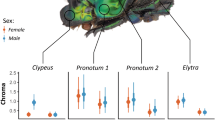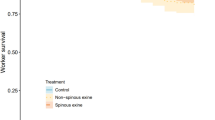Abstract
Adult oribatid mites are thought to live functionally in ‘enemy-free space’ due to numerous morphological and chemical defensive strategies. Most juvenile oribatid mites, however, lack hardened cuticles and are thus thought to be under stronger predation pressure. On the other hand, the majority of oribatids have exocrine oil glands in all developmental stages, possibly rendering chemical defense the crucial survival strategy in juvenile Oribatida. We manipulated tritonymphs of the model oribatid mite Archegozetes longisetosus to completely discharge their oil glands and offered these chemically disarmed specimens to the polyphagous rove beetle Stenus juno. Disarmed specimens were easily consumed. By contrast, specimens with filled oil glands were significantly protected, being rejected by the beetles. This is the first direct evidence that oil gland secretions provide soft-bodied juvenile oribatids with chemical protection against large arthropod predators.

Similar content being viewed by others
References
Betz O (1998) Comparative studies on the predatory behaviour of Stenus spp. (Coleoptera: Staphylinidae): the significance of its specialized labial apparatus. J Zool Lond 244:527–544
Grandjean F (1950) Observations sur les oribates (21e serie). Bulletin du Muséum National d’Histoire Naturelle 22:344–351
Hansen RA (2000) Effects of habitat complexity and composition on a diverse litter microarthropod assemblage. Ecology 81:1120–1132
Heethoff M, Raspotnig G (2011) Is 7-hydroxyphthalide a natural compound of oil gland secretions?—evidence from Archegozetes longisetosus (Acari, Oribatida). Acarologia 51:229–236
Heethoff M, Laumann M, Bergmann P (2007) Adding to the reproductive biology of the parthenogenetic oribatid mite, Archegozetes longisetosus (Acari, Oribatida, Trhypochthoniidae). Turk J Zool 31:151–159
Heethoff M, Koerner L, Norton RA, Raspotnig G (2011) Tasty but protected—first evidence of chemical defense in oribatid mites. J Chem Ecol 37:1037–1043
Jeffries MJ, Lawton JH (1984) Enemy free space and the structure of ecological communities. Biol J Linn Soc 23:269–286
Kupfer A, Maraun M (2003) Natural history notes: Ichthyophis kohtaoensis (Koh-Tao Caecilien): diet. Herpetol Rev 34:226
Maraun M, Scheu S (2000) The structure of oribatid mite communities (Acari, Oribatida): patterns, mechanisms and implications for future research. Ecography 23:374–383
Masuko K (1994) Specialized predation on oribatid mites by two species of the ant genus Myrmecina (Hymenoptera: Formicidae). Psyche 101:159–173
Molleman F, Walter DE (2001) Niche segregation and can-openers: scydmaenid beetles as predators of armoured mites in Australia. In: Halliday RB, Walter DE, Proctor HC, Norton RA, Colloff MJ (eds) Acarology: proceedings of the 10th international congress. CSIRO Publishing, Melbourne, pp 281–288
Norton RA (1994) Evolutionary aspects of oribatid mite life-histories and consequences for the origin of the Astigmata. In: Houck MA (ed) Mites. Ecological and evolutionary analyses of life-history pattern. Chapman & Hall, New York, pp 99–135
Norton RA (2007) Holistic acarology and ultimate causes: examples from the oribatid mites. In: Morales-Malacara JB, Behan-Pelletier V, Ueckermann E, Perez TM, Estrada-Venegas EG, Badii M (eds) Acarology XI: proceedings of the international congress. Sociedad Latinoamericana de Acarologia, Mexico, pp 3–20
Norton RA, MacNamara MC (1976) The common newt (Notophthalmus viridescens) as a predator of soil mites in New York. J Ga Entomol Soc 11:83–88
Peschel K, Norton RA, Scheu S, Maraun M (2006) Do oribatid mites live in enemy-free space? Evidence from feeding experiments with the predatory mite Pergamasus septentrionalis. Soil Biol Biochem 38:2985–2989
Raspotnig G (2006) Chemical alarm and defence in the oribatid mite Collohmannia gigantea (Acari: Oribatida). Exp Appl Acarol 39:177–194
Sakata T, Norton RA (2003) Opisthonotal gland chemistry of a middle-derivative oribatid mite, Archegozetes longisetosus (Acari: Trhypochthoniidae). Int J Acarology 29:345–350
Sanders FH, Norton RA (2004) Anatomy and function of the ptychoid defensive mechanism in the mite Euphthiradarus cooki (Acari: Oribatida). J Morphol 259:119–154
Saporito R, Donelly MA, Norton RA, Garaffo HM, Spande TF, Daly JW (2007) Oribatid mites as a major source for alkaloids in poison frogs. Proc Natl Acad Sci USA 104:8885–8890
Schaefer I, Norton RA, Scheu S, Maraun M (2010) Arthropod colonization of land—linking molecules and fossils in oribatid mites (Acari, Oribatida). Mol Phylogenet Evol 57:113–121
Schatz H (2002) Die Oribatidenliteratur und die beschriebenen Oribatidenarten (1758–2001)—Eine Analyse. Abhandlungen und Berichte des Naturkundemuseums Görlitz 74: 37–45
Schmelzle S, Helfen L, Norton RA, Heethoff M (2009) The ptychoid defensive mechanism in Euphthiracaroidea (Acari: Oribatida): a comparison of muscular elements with functional considerations. Arthropod Struct Dev 38:461–472
Schmid R (1988) Morphologische Anpassungen in einem Räuber-Beute-System: Ameisenkäfer (Scydmaenidae, Staphylinoidea) und gepanzerte Milben (Acari). Zoologische Jahrbücher Systematik 115:207–228
Schneider K, Maraun M (2009) Top-down control of soil microarthropods–evidence from a laboratory experiment. Siol Biol Biochem 41:170–175
Wilson EO (2005) Oribatid mite predation by small ants of the genus Pheidole. Insectes Soc 52:263–265
Acknowledgments
MH is funded by the German Science Foundation (DFG-Forschungsstipendium HE4593/3-1). We are deeply indebted to Lars Koerner for providing Stenus specimens and to Roy Norton for helpful comments on the manuscript.
Author information
Authors and Affiliations
Corresponding author
Electronic supplementary material
Below is the link to the electronic supplementary material.
Rights and permissions
About this article
Cite this article
Heethoff, M., Raspotnig, G. Expanding the ‘enemy-free space’ for oribatid mites: evidence for chemical defense of juvenile Archegozetes longisetosus against the rove beetle Stenus juno . Exp Appl Acarol 56, 93–97 (2012). https://doi.org/10.1007/s10493-011-9501-1
Received:
Accepted:
Published:
Issue Date:
DOI: https://doi.org/10.1007/s10493-011-9501-1




